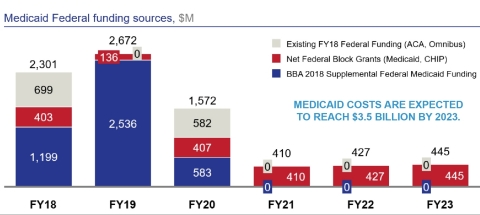NEW YORK--(BUSINESS WIRE)--Federal Medicaid funding has a critical role in providing affordable health care to the people of Puerto Rico, especially as the island works towards a sustainable recovery. But the vast difference in how Medicaid funding is calculated for Puerto Rico versus the 50 states is unfair, hurts more than a million American citizens, and prevents the island from effectively recovering from hurricane damage and its financial struggles.
Federal Medical Assistance Percentages (FMAP), which determine how much federal Medicaid funding each state receives, are based on actual costs and needs as economic circumstances change. A number of lower-income states, as well as the District of Columbia, have an FMAP rate of 70% or above. In Puerto Rico, however, the FMAP rate is statutorily capped at 55%. This is despite the Government Accountability Office concluding that the federal share would be 83% if it were calculated in the same way that it is for the 50 states. If the FMAP rates for the U.S. territories were calculated based on per capita income in the same way, each of the territories would have an FMAP rate in the 70-80% range.
The annual FMAP calculation uses a formula based on a state’s average personal income relative to the national average; states with lower average personal incomes have higher FMAPs. While the average personal income in Puerto Rico stands at approximately $19k while the U.S. average is $31k, Puerto Rico is subject to an overall dollar cap under Section 1108 of the Social Security Act, where the FMAP rate is applied only up to a predetermined dollar ceiling. No cap applies to any of the 50 states or the District of Columbia. The Section 1108 federal dollar cap is reset every year, with a $359.2 million cap in FY 2018, which covers only about 13% of Puerto Rico’s Medicaid costs. Eliminating the statutory cap on the FMAP rate would go a long way towards mitigating the severity of the impending Medicaid cliff. Its removal would also help bring long-term stability to both the Medicaid program and the island economy as a whole, by ensuring that the Medicaid funding Puerto Rico receives is consistent and reliable. Research shows that the influx of federal dollars from Medicaid spending has positive effects for state economies.
Why Congress Must Act Now to Fix the Problem
In order for Puerto Rico to establish a stable healthcare system in the years to come, Congress must act now to alleviate unfair burdens that have hampered Puerto Rico’s recovery. In a report by the Congressional Task Force on Economic Growth in Puerto Rico, it wrote: “If Congress does not enact legislation to avoid the impending Medicaid cliff, the consequences for the health care system in Puerto Rico are likely to be severe” and recommended “federal financing of the Medicaid programs in Puerto Rico and the other territories should be more closely tied to the size and needs of the territory’s low-income population.”1
At times, Congress has apportioned block grants to Puerto Rico as additional limited-time funding for Medicaid. The Affordable Care Act made an additional $6.3 billion available to Puerto Rico from July 2011 to September 2019, but the funds were running out by early 2018. The Bipartisan Budget Act of 2018 granted $4.8 billion with an expiration date of September 30, 2019.
If Congress doesn’t act by September of this year, funding for Medicaid in Puerto Rico will be drastically reduced, and the program would suffer an annual deficit starting in FY 2021. Medicaid costs are projected to rise to over $3.5 billion annually in FY 2023 from $2.8 billion for FY 2018.
Congress must act now to implement a meaningful restructuring of Medicaid that would infuse short-term resources, establish longer term certainty and set the stage for sustainable growth on the island.
Revitalize Puerto Rico is an effort funded by Assured Guaranty. For more information, visit RevitalizePuertoRico.com.
1. “Congressional Task Force on Economic Growth in Puerto Rico: Report to the House & Senate”. 114th Congress. December 20, 2016

